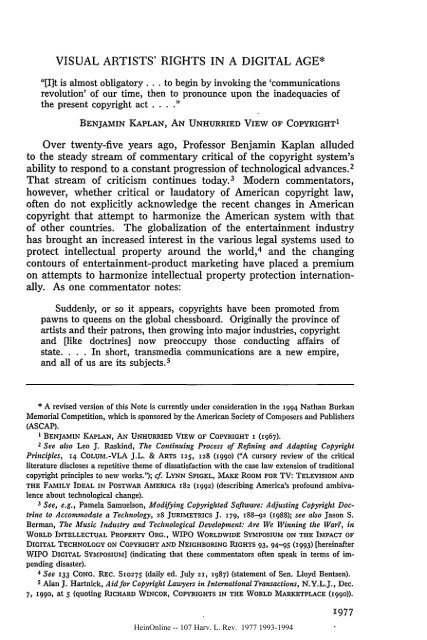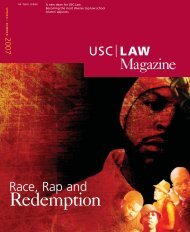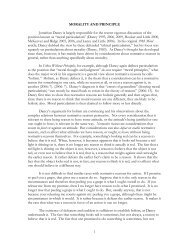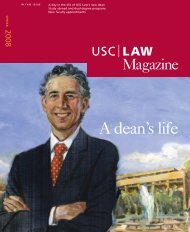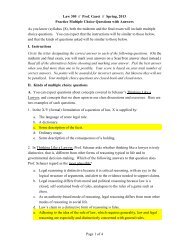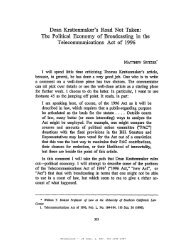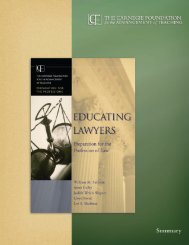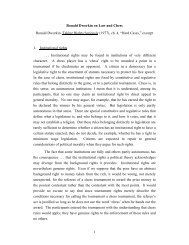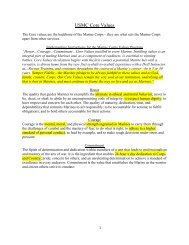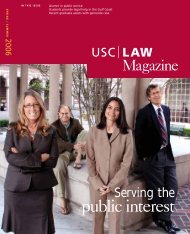EIN NLINE
EIN NLINE
EIN NLINE
Create successful ePaper yourself
Turn your PDF publications into a flip-book with our unique Google optimized e-Paper software.
VISUAL ARTISTS' RIGHTS IN A DIGITAL AGE*<br />
"[I]t is almost obligatory... to begin by invoking the 'communications<br />
revolution' of our time, then to pronounce upon the inadequacies of<br />
the present copyright act ... "<br />
BENJAMIN KAPLAN, AN UNHURRIED VIEW OF COPYRIGHT'<br />
Over twenty-five years ago, Professor Benjamin Kaplan alluded<br />
to the steady stream of commentary critical of the copyright system's<br />
ability to respond to a constant progression of technological advances. 2<br />
That stream of criticism continues today. 3 Modern commentators,<br />
however, whether critical or laudatory of American copyright law,<br />
often do not explicitly acknowledge the recent changes in American<br />
copyright that attempt to harmonize the American system with that<br />
of other countries. The globalization of the entertainment industry<br />
has brought an increased interest in the various legal systems used to<br />
protect intellectual property around the world, 4 and the changing<br />
contours of entertainment-product marketing have placed a premium<br />
on attempts to harmonize intellectual property protection internationally.<br />
As one commentator notes:<br />
Suddenly, or so it appears, copyrights have been promoted from<br />
pawns to queens on the global chessboard. Originally the province of<br />
artists and their patrons, then growing into major industries, copyright<br />
and [like doctrines] now preoccupy those conducting affairs of<br />
state. . . . In short, transmedia communications are a new empire,<br />
and all of us are its subjects. 5<br />
* A revised version of this Note is currently under consideration in the 1994 Nathan Burkan<br />
Memorial Competition, which is sponsored by the American Society of Composers and Publishers<br />
(ASCAP).<br />
I BENJAMIN KAPLAN, AN UNHURRIED VIEW OF COPYRIGHT I (1967).<br />
2 See also Leo J. Raskind, The Continuing Process of Refining and Adapting Copyright<br />
Principles, 14 COLuM.-VLA J.L. & ARTS 125, 128 (i9go) ("A cursory review of the critical<br />
literature discloses a repetitive theme of dissatisfaction with the case law extension of traditional<br />
copyright principles to new works."); cf. LYNN SPIGEL, MAKE ROOM FOR TV: TELEVISION AND<br />
THE FAMILY IDEAL IN POSTWAR AMERICA 182 (1992) (describing America's profound ambivalence<br />
about technological change).<br />
3 See, e.g., Pamela Samuelson, Modifying Copyrighted Software: Adjusting Copyright Doctrine<br />
to Accommodate a Technology, 28 JURIMETRICS J. 179, 188-92 (1988); see also Jason S.<br />
Berman, The Music Industry and Technological Development: Are We Winning the War, in<br />
WORLD INTELLECTUAL PROPERTY ORG., WIPO WORLDWIDE SYMPOSIUM ON THE IMPACT OF<br />
DIGITAL TECHNOLOGY ON COPYRIGHT AND NEIGHBORING RIGHTS 93, 94-95 (1993) [hereinafter<br />
WIPO DIGITAL SYMPOSIUM] (indicating that these commentators often speak in terms of impending<br />
disaster).<br />
4 See 133 CONG. REC. S1o275 (daily ed. July 21, 1987) (statement of Sen. Lloyd Bentsen).<br />
S Alan J. Hartnick, Aid for Copyright Lawyers in International Transactions, N.Y.L.J., Dec.<br />
7, 199 o , at 5 (quoting RICHARD WINCOR, COPYRIGHTS IN THE WORLD MARKETPLACE (1990)).<br />
HeinOnline -- 107 Harv. L. Rev. 1977 1993-1994<br />
1977


